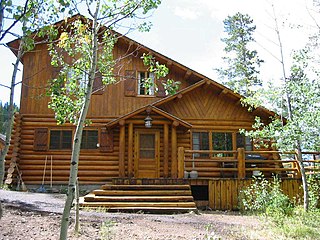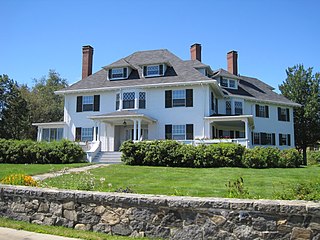
Yaddo is an artists' community located on a 400-acre (160 ha) estate in Saratoga Springs, New York. Its mission is "to nurture the creative process by providing an opportunity for artists to work without interruption in a supportive environment." On March 11, 2013 it was designated a National Historic Landmark.

George Foster Peabody was an American banker and philanthropist.

The Santanoni Preserve was once a private estate of approximately 13,000 acres (53 km²) in the Adirondack Mountains, and now is the property of the State of New York, at Newcomb, New York.
Pine Glenn Cove is a private vacation retreat, also known by various other names, including Hatch's Camp,Forest Hills, and St. Anne's Retreat. The property is located in Logan Canyon, Utah. Pine Glenn Cove is the largest private retreat in Cache National Forest and Logan Canyon, and the only one with a swimming pool. It has a long, rich history. Started by a wealthy businessman in the early 1910s, it was later expanded by his descendants. It was most famously owned by the Catholic Church in the later half of the 20th century and used as a spiritual retreat for nuns.

Spencer Trask was an American financier, philanthropist, and venture capitalist. Beginning in the 1870s, Trask began investing and supporting entrepreneurs, including Thomas Edison's invention of the electric light bulb and his electricity network. In 1896 he reorganized The New York Times, becoming its majority shareholder and chairman.

Upper Saranac Lake is one of three connected lakes, part of the Saranac River, in the towns of Santa Clara and Harrietstown, near the village of Saranac Lake in the Adirondacks in northern New York. Upper Saranac Lake is the sixth largest lake in the Adirondacks. With Middle Saranac Lake and Lower Saranac Lake, a 17-mile (27 km) paddle with only one carry is possible. There are 20 primitive campsites accessible by boat available on a first-come basis. Upper Saranac Lake is also known as Sin-ha-lo-nen-ne-pus.
The Redick Lodge, also known as the Chambers Lodge, is a private seasonal retreat on Upper Fremont Lake near Pinedale, Wyoming in the Wind River Range at an elevation of 7,500 feet (2,300 m). The lodge was designed by architect Otis Miller of Miles City, Montana as a log cabin on a stone foundation for George M. Redick, a Nebraskan who had worked with the Union Pacific Railroad on potential locations for company hotels. The Redick family spent summers at the lodge from 1918 through 1931, when family fortunes declined. The property was purchased by Dr. Oliver Chambers of Rock Springs, Wyoming in 1938 and has remained in the Chambers family.

The Brinkerhoff is an historic lodge in Grand Teton National Park on the shore of Jackson Lake. It is the last remaining example of a forest lease vacation lodge in the park. The log house and caretaker's lodge were designed by architect Jan Wilking of Casper, Wyoming and were built in 1946 in what was then U.S. Forest Service land for the Brinkerhoff family. After the creation of Grand Teton National Park, the National Park Service acquired the property and used it for VIP housing. Among the guests at the Brinkerhoff were John F. Kennedy and Richard M. Nixon. The lodge is also notable as a post-war adaptation of the rustic style of architecture. The interior is an intact example of this transitional style.

Lake George is a town in Warren County, New York, United States. The population was 3,578 at the 2000 census. The town is named after the lake, Lake George. The town surrounds the Village of Lake George. The town is part of the Glens Falls Metropolitan Statistical Area.

The Wiawaka bateaux are a cluster of shipwrecks in Lake George, New York State. The seven British and colonial bateaux were scuttled in 1758 during the French and Indian Wars, with the intention of recovery in 1759. This never happened, and their wrecks were discovered between 1963 and 1964 by archaeological diver Terry Crandall, working under the auspices of the Adirondack Museum. The site was listed on the National Register of Historic Places in 1992.
Forest Lodge is a hunting and vacation retreat of the Livingston/Griggs family on the shore of Lake Namekagon within the town of Namakagon, Wisconsin. The complex consists of 16 rustic structures built from 1893 to about 1950. Since 1999 it has been managed by the Chequamegon-Nicolet National Forest. It was added to the National Register of Historic Places in 2002.

The El Pomar Estate was the Penrose House and estate of Spencer and Julie Penrose in the Broadmoor, Colorado, Colorado Springs, Colorado It is listed on the National Register of Historic Places listings in El Paso County, Colorado and the Colorado State Register of Historic Properties.
Wandawega Lake and Wandawega Lake Resort, also known asCamp Wandawega, are located in Elkhorn, Wisconsin. The historic Camp Wandawega is listed on the National Register of Historic Places and the Wisconsin Register of Historic Places. The camp buildings dates to the 1920s when the modest resort was built and operated as a brothel and speakeasy. After many run-ins with the law, the madam, Annie Peck, was finally convicted of running "a bawdy house of ill fame", and sent to the women's prison in Taycheedah, WI in 1942. Her husband Gordon Peck was also convicted and served time. The resort was reopened circa 1950 as the Wandawega Lake Resort. The property was purchased by a Latvian order of Catholic priests in 1961. The Latvian Marian Fathers used the property as a Latvian Catholic cultural retreat center, including an informal kid's camp in the 1970s. The current owners, David Hernandez and Tereasa Surratt, advertising executives from Chicago, have been restoring the property since 2004. Hernandez attended the camp as a child, as he is half-Latvian and his family were regulars there from the 1960s to the 1980s. The camp is on 25 acres and includes a 3-story hotel, lodge, cottages, and historic memorabilia.

The Little Boar's Head Historic District encompasses an area of summer resort and beachfront properties in North Hampton, New Hampshire. Located on New Hampshire's seacoast roughly between North Hampton State Beach and Bass Beach, the district is almost entirely residential, consisting mainly of houses built as summer vacation spots in the late 19th and early 20th centuries, with associated beachfront amenities. The district was listed on the National Register of Historic Places in 1999.

E. M. Backus Lodge, also known as Camp Toxaway, The Cold Mountain Lodge and Canaan Land Christian Retreat , is a historic hunting lodge and national historic district located near Lake Toxaway, Jackson County and Transylvania County, North Carolina. The lodge was built about 1903, and is a 2-story, double-pile house of chestnut logs. The lodge contains eight rooms on two floors, each grouped around a central hall. Also on the property are the contributing log stable, caretaker's cottage, guest cottage, barn, and Davis Cottage. The site was the former hunting lodge of Thomas Edison, Henry Ford and Harvey Firestone. The camp became an exclusive girls' camp, Camp Toxaway, in 1922, and a religious and educational retreat in 1955 known as Canaan Land. The estate was bought by George and Nancy Corbett of Florida in 1986 and is still operated by the Corbett family.

Michillinda Lodge is a summer resort on the Lake Michigan shoreline in Whitehall, Michigan. Its current property was purchased in 1894 by a group of leaseholders and investors from Michigan, Illinois, and Indiana, and named "MICH-ILL-INDA" in reference to those states in 1895. Originally a residential beach association, in 1920 Emanuel "Manny" Duttenhofer purchased an 18-room, 13,000-square-foot (1,200 m2) summer house on the site, which he subsequently opened as a resort.

The Charnley-Norwood House is a summer (winter) cottage designed by architects Louis Sullivan and Frank Lloyd Wright in 1890 in Ocean Springs, Mississippi on the Mississippi Gulf Coast. The home was built as a vacation residence for James Charnley, a wealthy Chicago lumber baron, and its style represents an important change in American residential architecture known as Prairie School.
The Adolph Levin Cottage is a historic vacation property on Kabetogama Lake in St. Louis County, Minnesota, United States. It contains a log cabin built in 1937 for two friends, Dr. Adolph Levin and George Plager. A metal water tank and the surrounding landscape are also contributing historic features. It is now preserved within Voyageurs National Park as an example of the early tourism and recreational properties in the area. In 2011 the property was listed on the National Register of Historic Places for its significance in the themes of architecture and entertainment/recreation. It was nominated for being a representative early-20th-century lake retreat, and for the rustic architecture and traditional Finnish construction of the cabin.
Sherwood Lodge, in Glacier National Park near West Glacier, Montana, was built in 1919. It was listed on the National Register of Historic Places in 2008.




















